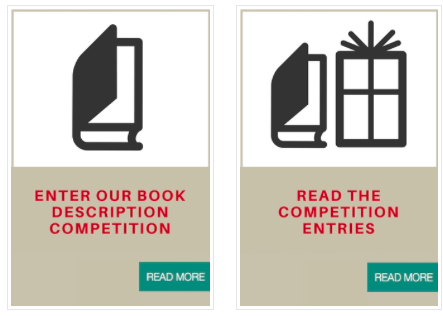Indie authors often say that writing the blurb for the back cover of their self-published book is the most difficult part of the whole process, so we're glad to bring you this simple and straightforward set of guidelines from Fred Johnson of ALLi Partner Member Standout Books to help you triumph over this troublesome task.
The Art of Blurb-Writing
The humble blurb can easily be forgotten, overshadowed by its more pressing rivals, the edit, the marketing campaign, and the cover design. But ignore the blurb at your own peril—it is the bridge between the mildly interested potential reader and the money-down customer. Here are five tips to help ensure readers stick with your book after they pick it up.
1) Know What a Blurb Should Do
This one sounds obvious, but it’s important to remember that a blurb is not just a synopsis or summary of your plot. Such “book report” blurbs do not entice readers. Rather, they give out too much information and, worse, present it in a dull manner.
A blurb should provide key information about the book’s plot (setting, time period, protagonists), outline the main conflict, and incorporate the book’s marketable themes. These themes are essentially easily digestible nuggets boiled down from your book’s plot. Consider, for example, these themes from The Lord of the Rings:
- “Good overcomes evil”
- “David beats Goliath”
- “Friendship overcomes hatred”
Detail the plot only as far as the main hook – you want to give your readers a little taste but leave them wanting more.
As part of our Indie Author Fringe Online Conference we're hosting a BOOK DESCRIPTION COMPETITION.
2) Keep the Tone Consistent
It’s very important for your blurb to match the tone of your book. You wouldn’t expect a flippant, jolly blurb on the back of a gritty thriller full of murder and intrigue—such discrepancy can be misleading.
Consider this rather farcical blurb for American Psycho, one of the most infamously unpleasant novels of the 20th century:
“Patrick Bateman is rich, single, and ready to mingle. He’s got it all – a great job, a penthouse suite, and more than a few charming lady friends. There’s just one teeny-weeny problem: Bateman loves murdering people! What ever will his boss say?”
This blurb sets the reader up for an absurd and dark comedy of errors, which of course is not quite what they would get.
3) Keep an Eye on Style
A good rule of writing in general is to avoid too many sentences strung together of similar length. There’s that wonderful Gary Provost quote that exemplifies this tenet perfectly.
Such variety is doubly important in texts as short as blurbs. You need to keep the prose lively, engaging, and vibrant. It must have, as Provost writes, “a pleasant rhythm, a lilt, a harmony.” Avoid droning on with too-long sentences. You want to intrigue a wide range of readers, not have them get tangled in overly complex text.
Similarly, avoid repetition of all kinds, and keep an eye on words that are spelt the same. Have a look at this passage:
“When it came to demeanour, there was nobody in class as classy as him.”
In this sentence, “class” and “classy” are two different words performing different functions, but they still make the sentence appear cramped and jarring. It’s better to be as diverse as you can in your language use.
You’ll also want to stay away from hyperbole. It’s a dishonest technique that can make a reader feel like they’ve been tricked into buying your book.
Finally, avoid cliches. You should be trying to communicate how your book is different from others in its genre, and by slipping into clichéd phrases you’re achieving the opposite by evoking stock images and stereotypes.
4) Mention Author Accolades
If your book has received any positive reviews, if you’ve won any awards, or if you’ve had work published in any journals or magazines, you’re going to want to include this information. Readers love to be reassured, and if an authority on the subject has enjoyed your book, then they’re more likely to buy it.
5) Focus on the Protagonist(s)
It can be difficult boiling a complex plot down into a blurb. You have to be really ruthless in what you deem important enough to be mentioned. For this reason, it’s always best to forget supporting characters and to focus only on your book’s protagonists.
If you mention too many characters, you’ll likely confuse the reader and your blurb will swell in size until it won’t fit on the back cover.
A good way to prepare is to try to reduce your plot to a single sentence. I’ve yet to encounter a book where this can’t be done. Even Moby Dick can be cut down:
“Sailor joins obsessive captain's crew on hunt for symbolically rich white whale in early 19th century America.”
Done. All the important information is in there. You’ve got the setting, time period, protagonists, and main plot all in a single sentence. Now you know your book’s backbone, you can dress it up and make it pretty. Go forth!
OVER TO YOU If you have any top tips to add to Fred Johnson's excellent advice, we'd love to hear them!
#Authors - struggle over book blurbs? Help is here! - from @StandoutBooks on our blog Share on XOTHER GREAT POSTS ABOUT BOOK BLURBS








[…] How to Write a Blurb for a Self-published Book […]
[…] https://selfpublishingadvice.org/how-to-write-a-blurb-for-a-self-published-book/ […]
There is always a lot of information and advice for novels. But how about writing an article on how to write a self-published, nonfiction blurb?
[…] How to Write a Blurb for a Self-published Book […]
[…] https://selfpublishingadvice.org/how-to-write-a-blurb-for-a-self-published-book/ […]
[…] How to Write a Blurb for a Self-published Book by Fred Johnson […]
[…] Read the entire article… […]
[…] Here is a post about something a lot of people hate: writing a blurb for their book. […]
Thank you for the advice!
You’re very welcome! I’m glad you enjoyed the article.
Particularly interested in the accolades section of this post, and a question on that subject – by the time we’ve knocked around a bit, and especially if we write shorts and poetry so have a lot of chances for publication in journals, we are likely to have quite a few things to put here, so how do we do a similar pruning exercise to the one you suggest for plot? Should we focus on most recent, most prestigious, most relevant to audience, and how would we mix the presentation of prizes and publications? This is the section where the great gripping stuff of the plot part often seems to dissipate so pointers would be very welcome.
An eyebrow-aloft question:
““Patrick Bateman is rich, single, and ready to mingle. He’s got it all – a great job, a penthouse suite, and more than a few charming lady friends. There’s just one teeny-weeny problem: Bateman loves murdering people! What ever will his boss say?”
This blurb sets the reader up for an absurd and dark comedy of errors, which of course is not quite what they would get.”
Have you read American Psycho? Because “an absurd and dark comedy of errors” is *exactly* what it is. It’s John Waters for the page, and this blurb, to me, is note perfect!
Hi Dan, thanks for your comment and apologies for the late response. In terms of accolades, I’d always go for the most prestigious. The trick is in prioritising and in keeping the accolades section brief and to the point–you don’t want to steal attention away from the actual plot. As a rule, awards and nominations should always trump publication history (unless the award was minor and the publication is something huge, like The New Yorker or Harper’s.) I hope this has been helpful!
And I have read American Psycho, though I can’t say I found it to be a comedy of errors at all! Still, we all take different things from books.
Best of luck with your own work.